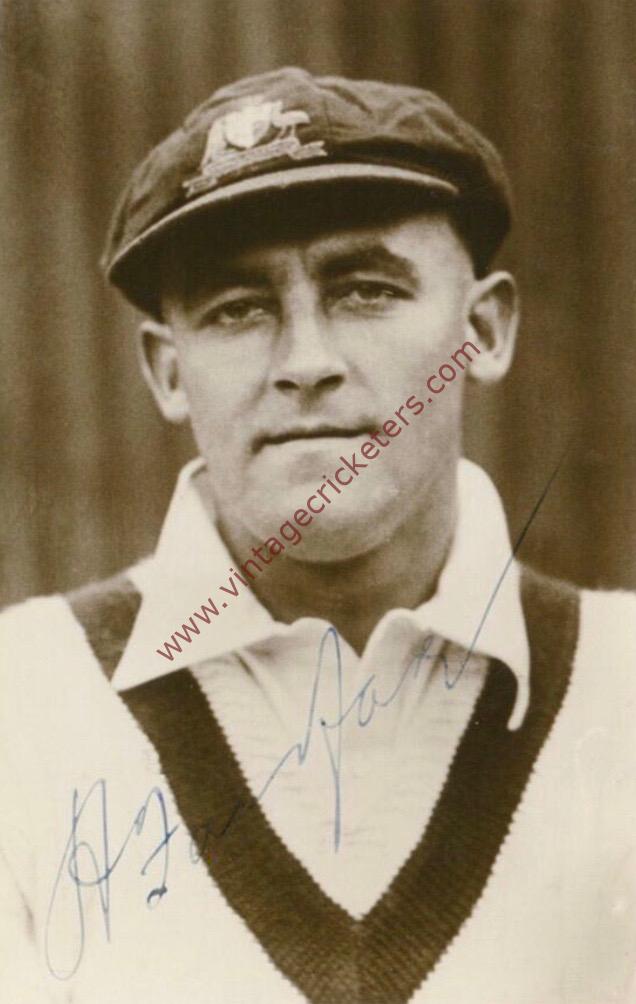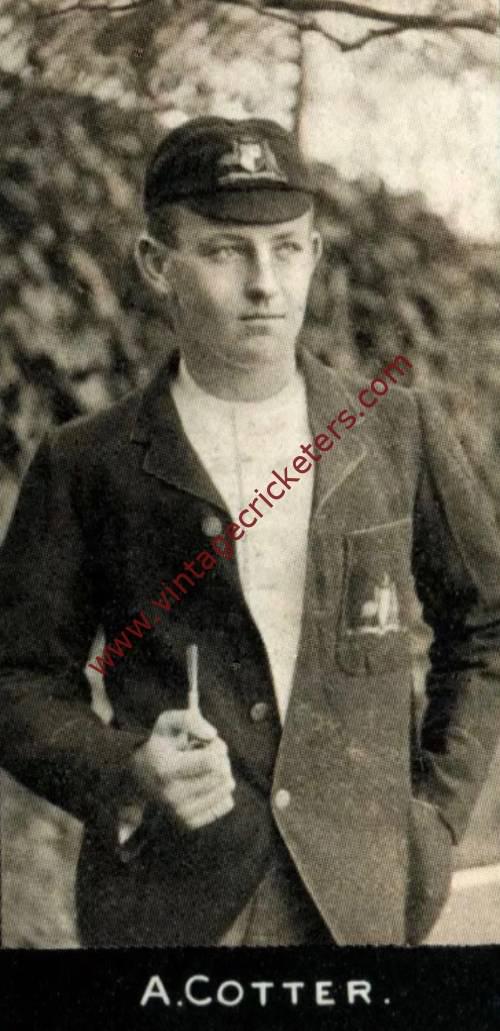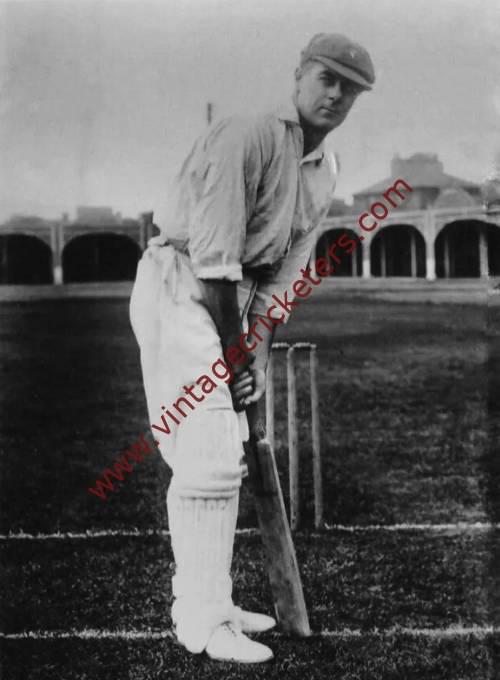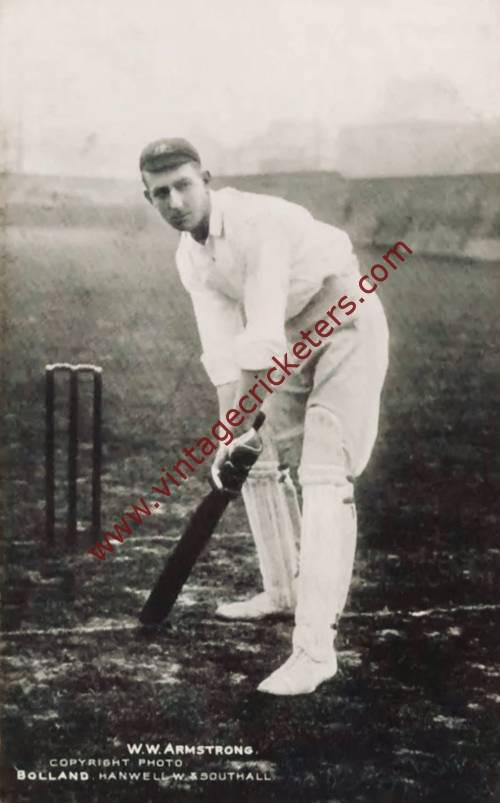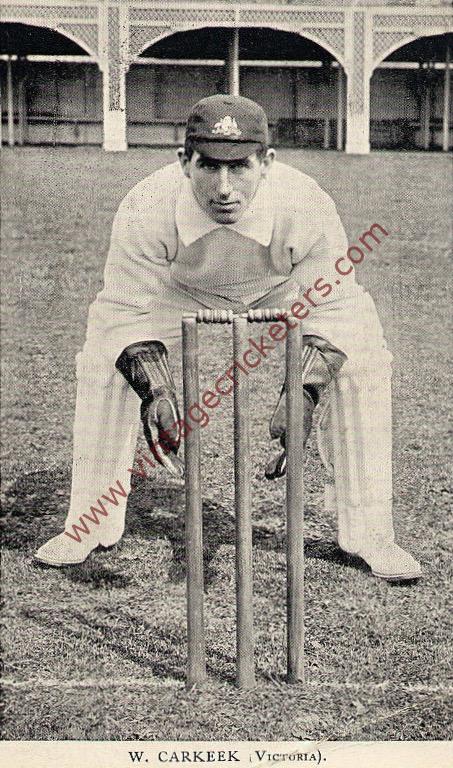Summer Hill, Sydney, New South Wales born all-rounder Alan Fairfax had a rapid rise to international honours, making his Test match debut for Australia in the same season as his first class debut for New South Wales. Having played for St George in grade cricket for several seasons, his form improved over the 1927-28 summer, scoring a century against Cumberland. Good form early in 1928-29 saw him selected for New South Wales Colts in October 1928. He scored 107 against Queensland Colts.
Fairfax made his first class debut shortly afterwards, playing for New South Wales against Victoria, opening the batting with Archie Jackson. He made 2 and 30 and took 1-30 and 3-45 in a drawn match. Fairfax’s second State game was against Queensland; he took 1-69 and 2-66 and scored 58 and 9. Fairfax batted down the order against South Australia, scoring 36 and 20 and taking 4-54 and 3-82, making him New South Wales’ best bowler in their victory.Fairfax’ fourth first glass game was against Victoria. He was back as opener and scored 104 in the first innings – his maiden (and, as it turned out, only) first class century, though overshone by Don Bradman’s sensational 340. He took 0-35 and 2-54 with the ball.
He was described “A bowler of his years able to make runs in this way is well worthy of keen consideration. Fairfax is a hard-driving batsman, and a medium-pace bowler. With his club at first, he was inclined to bowl too fast. He has dropped to medium pace, and, as a result, has a good change of pace in. the fast ball, and is able to spin the ball at his normal pace. Besides, he is not above sending down a yorker — a ball most bowlers these days have quite forgotten.” and another comment said of him “Fairfax has cricket in him.- He would probably be at his best going in seventh or eighth in a crack side… He has been doing something useful with bat and ball in each representative game he has played. He has height and reach, and drives well.”
Another writer said of him “Over six feet, straight as a ramrod, for one his size he is remarkably quick on his feet. Fairfax has a taking style of bowling, with a free swinging high over-arm delivery. If he cultivates some of the subtleties such as characterised H. Trumble, G. Giffen, and M. A. Noble, he may become a top-sawyer. His height and high delivery alone are deadly assets on wickets affected by rain. He is a keen field, as befits a good baseballer. As batsman, Fairfax has the fundamental of defence. On top of that, he can hit the ball as hard as any man in the game this season. And he is good at the pinch.”
Fairfax then impressed in a rain-shortened State game against the touring English side, top scoring with 40 in the first innings and taking 3-36 opening the bowling, his victims including Jack Hobbs, Maurice Leyland and Percy Chapman. Fairfax then scored 17 and 41 and took 0-47 and 4-55 against South Australia, bowling his team to a 60 run victory.
These consistent performances led to his selection in the fifth Test match against the England at Melbourne in March 1929. It had been a rapid rise, selected for international honours only a few weeks after his first class debut, but the selectors were keen to trial new players at the end of what had been a disastrous series for Australia: other debutants selected for that game included Percy Hornibrook and Tim Wall; it was only the second test for Don Bradman and Archie Jackson and the third test for Ron Oxenham. Fairfax and Oxenham played in tandem as all rounders.
Fairfax had a strong Test debut, taking the wickets of Patsy Hendren and Wally Hammond in either innings, and also taking catches to dismiss Hammond, George Duckworth, Maurice Leyland, Jack Hobbs and Maurice Tate. When Australia batted, Fairfax came to the wicket when his team was 203-4 and took part in a record 183 run partnership with Don Bradman, Fairfax making 65. He was not required to bat in the second innings, with Australia winning by five wickets. In his debut first class season, Fairfax had scored 422 runs that summer at 38.36 and taken 25 wickets at 27.08 apiece.
Fairfax’s domestic performances were solid the following summer. He scored 49 and 21 against Queensland, picking up 3-47 in both innings as New South Wales won by 23 runs. He was picked to play the M.C.C., making 14 and 19 as opener and taking 4-102 and 0-7 opening the bowling. He then played for a Bill Woodfull XI against a Jack Ryder XI; scoring 27 and 26 without taking a wicket. Fairfax played against South Australia, making 39 and 46 and taking 3-80 and 1-39, and against Victoria he took 5-104 in their second innings, his first five wicket haul. Fairfax was part of the Shield game where Bradman scored 452 and Queensland was defeated by 685 runs; Fairfax’s contribution was 20 and 10 and 0-12. Against South Australia he scored 29 and took 3-43 and 4-19, helping bowl New South Wales to victory by an innings and 220 runs.. He ended the summer with 64 and 2-44 against Victoria, and despite his underwhelming batting that summer he was then selected in the Australian squad to tour England in 1930 as it was thought his bowling would be effective on English pitches.
Fairfax’s first class debut on English soil was a tour game against Worcestershire, where he took 4-36 in the first innings, and after several steady performances including 6-54 against the M.C.C. he was picked for the First Test at Nottingham in June 1930, as Australia lost by 93 runs. In the Second Test at Lord’s Fairfax took 4-101 in England’s first innings, the wickets being Hobbs, Frank Woolley, Hendren and Gubby Allen. Batting at eight in Australia’s first innings, he made 20 not out, with Bradman scoring his famous 254. Fairfax took 2-37 in England’s second innings, dismissing Percy Chapman and taking a catch to get Hammond as Australia won by seven wickets.
Having missed the Third Test through illness he returned at Old Trafford. In Australia’s first innings, Fairfax came to the wicket when the score was a tricky 190-5; he scored 49 off 208 balls and was dismissed at 330-8 as Australia scored 345 in a rain-affected draw. The Ashes were still in the balance going into the Fifth Test at The Oval, with the series at 1-1. Fairfax took 3-52 in England’s first innings of 405, including Sutcliffe and Bob Wyatt, as well as taking a catch to dismiss Kumar Duleepsinhji. When Australia batted, Fairfax made 53 not out off 163 balls as Australia put on 695 (Bradman made 232 and Ponsford 110). In England’s second innings Fairfax took 1-21 (he was the bowler who dismissed Jack Hobbs in his last Test innings) and took catches to dismiss Hammond and Sutcliffe as Australia won by an innings and 39 runs to win The Ashes. It had been an excellent tour for Fairfax, who scored 150 test runs at a healthy average of 50 (helped by two not outs) and 536 first class runs at an average of 25.52 with three half centuries. He took 12 test wickets at 27 and 41 first class wickets at 29.70 (making him Australia’s fourth highest wicket taker after Grimmett, Hornibrook and Wall. In November 1930 Don Bradman praised Fairfax as the best all rounder in Australia and said he always saved his best for the Test matches.
He kept his place in the Test side for the First Test against The West Indies at Adelaide in December 1930 and played in all five of the Test matches that winter, taking 4-31 in the Fourth Test at Melbourne, and scoring 54 and 60 not out at Sydney in the Fifth Test as Australia lost the match by 30 runs. However Fairfax had been unable to find a job in The Depression. In November 1931 it was announced he had signed a deal to play as a professional for Accrington in the Lancashire League at £20 a week. It was a relatively uncontroversial decision at the time – something Don Bradman brought up in 1932-33 when he was much critcised for considering an offer to play league cricket. He was to leave in March but he ruled himself out of international cricket having played 10 Test matches for Australia.
He only played two further first class games for New South Wales, against Queensland and also the touring South Africans. He was not available for the Tests against South Africa – Ron Oxenham took his place. Fairfax then played in the Lancashire League for two summers. In 1932 he made 738 runs at 32.08 and took 43 wickets at 20.11. In 1933 he made 952 runs at 52.88 and took 51 wickets at 16.45.
In 1934 Fairfax set up an indoor cricket school in London which he ran until 1937 when it shut down. In 1934 he played his last first class game for The Gentlemen against The Players, scoring 15 and not taking a wicket. In 1937 he coached cricket at Eton and worked for Sir Julien Cahn’s private team, and in 1939 he coached Nottinghamshire. He served as a pilot in the RAF during the Second World War but suffered health problems from an injury incurred during the War. He fell ill just before Christmas 1954 and died in London in May 1955 at age 48.
Vintage Cricketers was founded in July 2019. There are more photographs of this cricketer in the Vintage Cricketers library, which are due to be loaded in due course. In the meantime, please send a message to us using the contact form at the bottom left of this page and we can arrange to prepare and publish all images of this cricketer if you have a particular interest in him.

